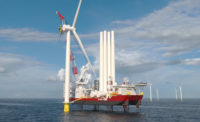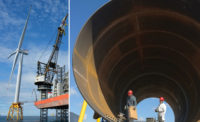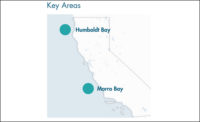Alla Weinstein describes her life as a series of “unplanned events,” but competitors describe the offshore wind power technology pioneer and serial entrepreneur as “tenacious and focused” in her push to have lots of floating turbines generating power, and revenue, in deep water off California—and elsewhere.

Experts point to as much as 800 GW of available wind energy off the West Coast, but state and federal officials never saw development as a serious commercial enterprise; 96% of California’s offshore wind is in water too deep to support more common fixed turbines.
Weinstein has designed and tested an alternative floating platform, and many credit this founder and CEO of start-up Trident Winds LLC with the foresight two years ago to submit an unsolicited proposal to regulators to build a floating wind farm off the California coast.
“It literally woke up California,” she says. Weinstein scored a breakthrough this year when the U.S. Interior Dept. agreed to open 1,200 sq miles of ocean for development.
Karen Douglas, a state energy commissioner, says she changed perceptions that “offshore wind was too expensive to pursue.”
Support for offshore wind is likely to grow thanks to a recently enacted state mandate for 60% of energy from renewable sources by 2030 and 100% by 2045. Trident and its bigger German energy partner EnBW signed a deal in November with Morro Bay, Calif., to build a 1,000-MW project by 2026.
Weinstein’s engineering pragmatism led to an innovative community benefits agreement and to a $250,000 payment for exclusive access to existing city infrastructure to expedite power delivery.
A 1974 Soviet émigré trained as an aerospace engineer, she earned a U.S. electrical engineering degree but landed at contractor Honeywell only through a loophole it found in her immigration status. For 10 of her 20 years at the firm, she was its only female engineer.
Weinstein’s work in renewable energy dates to 2000 with a wave-power technology firm she founded in Washington state.
“When I closed the door to the Soviet Union, I believed you can start from impossible and figure it out,” she says, switching her focus to modifying oil platforms with wind turbines and launching Principle Power LLC to develop and test the WindFloat technology in Europe.
While raising capital, she founded and was the first president of the European Ocean Energy Association.
CEO Weinstein left the firm in 2013 and says she will also consider other floating platforms for the Morro Bay project as it progresses, but WindFloat’s promise gained about $100 million in European funding last year for a larger 25-MW floating wind farm to be built off Portugal.
Principle, with partners, also was picked last year by a northern California utility in Eureka to co-develop a 100-MW to 150-MW project about 20 miles off Humboldt Bay.
Even with stakeholder hurdles to come, Joao Metelo, now Principle Power CEO, calls the project a “game changer” for the U.S.
In a statement, the utility cited the team’s mature, cost-competitive floating wind technology and its capacity to develop, finance, operate and build the project and a future supply chain.







Post a comment to this article
Report Abusive Comment